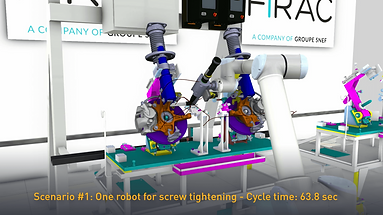FiRAC used Visual Components simulation to automate a manual sub-assembly process at a car manufacturing plant in France.
Project:
Automating a manual sub-assembly process in a car manufacturing plant
Industry:
Automotive – Manufacturing
Customer:
PSA Group

The Challenge
In automotive manufacturing, production times are vital and so is the quality. In this case, the PSA Group’s automotive manufacturing plant in Sochaux, France, was looking to optimize front-wheel screw tightening to accelerate cycle times and improve the production quality.
Screw tightening at the plant was previously being performed manually, so in addition to creating an automated solution, cycle times had to remain fast and consistent to ensure overall productivity goals were met.

“Any second lost during this process means a loss of productivity in the mainline considering a car is produced about every 60 seconds”
Corentin Monnot, Project Manager at FiRAC.
The Results
Automating the Process
FiRAC utilised Visual Components 3D manufacturing simulation to conduct a variety of scenarios to help PSA Group automate the process. Scenarios consisted of using just one robot, two robots facing the product and two robots face-to-face, among others.
The first scenario that was tested included just one robot performing the screw tightening task, which it performed in just over a minute.
The second scenario included simulating two robots side-by-side, one that was tightening the four M6 screws and the second that was tightening the M8 screw. This cycle time clocked in at 54.8 seconds.
The final third scenario was designed with two robots, but in a face-to-face setup. This proved to be the most optimal solution and the fastest simulation of the process, completing the task in under 53 seconds. This was the simulation that was accepted by PSA Group, as it proved to be the ideal compromise between cost and performance.

"Visual Components is so versatile that it was very easy to implement the different configurations and view their effect on the cycle time. Once we found the best simulation, we were able to edit a video of the process and provide quantified and visual reasoning to support our final solution."
Corentin Monnot, Project Manager at FiRAC
The Visual Components Advantage
FiRAC competitors that were also consulted for this project insisted that the process could be automated using only one robot. However, these competing firms failed to show any visualization to truly demonstrate how it could be done quickly and efficiently.
In addition to the visual representation of the process, Visual Components allowed FiRAC to consider multiple external time-consuming factors and anticipate their effect. Thus, the AGV moving time, the screw tightening time, or even the camera process time were taken into account very early stage, therefore providing a strong engineering background to the proposal.
That was one of the big advantages of using the Visual Components software that the visualized and validated proposal could be effectively communicated to PSA Group.
"The customer was really impressed with the visual implementation of the process – and that’s how FiRAC got the competitive edge to win this project."
Corentin Monnot, Project Manager at FiRAC
Visit our group sites
Systems Ltd
Systems Ltd
Services Ltd



